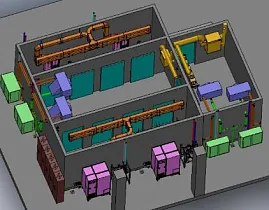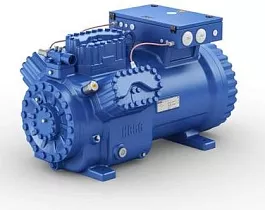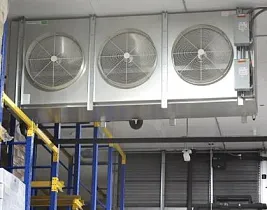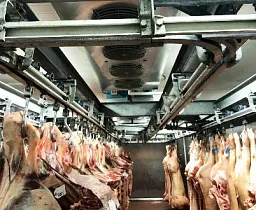
Refrigeration Equipment Market size was valued at USD 59,367.10 Million in 2021 and is projected to reach USD 1,05,801.77 Million by 2030, growing at a CAGR of 5.6% from 2023 to 2030.
Owing to rapid urbanization and changing lifestyles & preferences have led to an increased demand for packaged food and beverages among urbanized consumers. Frozen foods are an affordable way for getting the daily dose of fruits and vegetables. The Global Refrigeration Equipment Market report provides a holistic evaluation of the market. The report offers a comprehensive analysis of key segments, trends, drivers, restraints, competitive landscape, and factors that are playing a substantial role in the market.
In general, refrigeration is defined as the process of mechanically cooling or reducing the temperature of a space, a product, or a process. Refrigeration Equipment refers to any equipment whose purpose is to lower air and product temperatures and/or to control relative humidity. The key components of refrigeration systems include compressors, condensers, evaporators, expansion devices, and many others. Different types of refrigeration systems are available including mechanical-compression refrigeration systems, absorption refrigeration, evaporative cooling, and thermoelectric refrigeration. Refrigeration Equipment is used in various applications such as household refrigerators, industrial freezers, cryogenics, air conditioning, and others.
The compressor present in the refrigeration system is used for compressing the refrigerant from the evaporator and raising its pressure so that the corresponding temperature is higher than that of the cooling medium. The condenser plays an important role and is used in the high-pressure side of a refrigeration system. The main purpose of the condenser is to liquefy the refrigerant gas sucked by the compressor from the evaporator. The evaporator is used in the low-pressure side of a refrigeration system and is responsible for cooling the air going to the space by boiling (evaporating) the refrigerant flowing through it. In the evaporator, the temperature of the boiling refrigerant must always be less than that of the surrounding medium so that the heat flows to the refrigerant. The expansion device, also known as the throttling device is connected between the receiver and the evaporator and separates the high-pressure side and the low-pressure side of a refrigeration system. It is connected between the receiver and the evaporator.
Various types of refrigerants are used in Refrigeration Equipment based on their chemical composition such as CFC, HCFC, ammonia, carbon dioxide, and many others. The design of the refrigeration system depends strongly on the properties of the selected refrigerant. The selection of the right refrigerant involves compromises between conflicting desirable thermo-physical properties. A refrigerant selected must satisfy many requirements, some of which do not directly relate to its ability to transfer heat. Chemical stability under conditions of use is considered an essential characteristic. For some applications, safety codes may require a non-flammable refrigerant of low toxicity. The environmental outcomes of refrigerant leaks must also be considered. Other concerns such as cost, availability, efficiency, and compatibility with compressor lubricants and equipment materials are also taken into consideration.
Owing to rapid urbanization and changing lifestyles & preferences have led to the increased demand for packaged food and beverages among urbanized consumers. Frozen foods are an affordable way for getting the daily dose of fruits and vegetables. In fact, families incorporating frozen foods into their normal routine may have better diet quality. According to the Academy of Nutrition & Dietetics, fruits, and vegetables picked at peak ripeness are often frozen within hours, locking in nutrients and flavor. Usually, frozen foods retain their vitamins and minerals and there is no change to the carbohydrate, protein, or fat content. In some cases, frozen foods have more vitamins and minerals when compared to fresh as fresh foods lose vitamins and minerals over time while freezing helps in preserving nutrients.
Frozen foods can be a convenient and affordable way for incorporating healthy foods from every food group, including whole grains, fruits, vegetables, protein, and dairy. In addition to a time-saving convenience, frozen foods can be beneficial for individuals with limited kitchen space or utensils. Frozen foods are not only more affordable in price, but they also help in reducing food waste. These advantages bode well for urban consumers, who seek convenient, ready-to-eat meals in order to suit their evolving and fast-paced lifestyles. This trend has resulted in the accelerated demand for refrigeration equipment.
With rising global demand for sustainability, natural refrigerant technologies are meeting the highest standards for energy efficiency and refrigerant usage worldwide. Natural refrigerants help in lowering CO2 emissions, have very low global warming potential, and consume up to 45% less energy than hydrofluorocarbons (HFCs). In fact, refrigeration systems using natural refrigerants already comply with new Environmental Protection Agency (EPA) regulations while helping OEMs in achieving the Department of Energy’s minimum efficiency performance standards for 2017 and 2018.
Some of the regulatory standards comprising the directives for the quality of food include the Food Quality Protection Act in the U.S., the Food Safety Law of the People’s Republic of China, the General Food Law Regulation, and the Food Quality Policy in the EU. Moreover, the EU introduced EU fluorinated greenhouse gas (F gas) regulation for phasing out Hydro-fluorocarbons (HFCs) and related product bans in 2014. The regulation includes the manufacturing process, service equipment, production, wholesale, and trade of F gas and related products. Such regulations are expected to generate demand for natural refrigerants as an environmentally friendly alternative for conserving edibles, in conjunction with compliance with food quality standards.
The image of market attractiveness provided would further help to get information about the region that is majorly leading in the Global Refrigeration Equipment Market. We cover the major impacting factors driving the industry growth in the given region.
The Global Refrigeration Equipment Market is Segmented on the Basis of Refrigerant Type, Application, Component, And Geography.
Based on Refrigerant Type, the market is bifurcated into HFCs, Hydrocarbon Refrigerants, Ammonia Refrigerants, CO2 Refrigerants, and Others. HFCs refer to the hydrofluorocarbons which are used as refrigerants in various applications including automotive, home air conditioners, and industrial refrigeration. HFCs were introduced into the refrigeration market as a replacement for ozone-damaging refrigerants like chlorofluorocarbons (CFC) and hydrochlorofluorocarbons (HCFC). Due to the rapid phase-out of CFC and HCFC refrigerants, HFC refrigerants became the preferred choice as they do not contain chlorine and did not fuel the ozone depletion. The most prominent HFC used was R-134a.
However, later it was observed that HFCs have a very high Global Warming Potential (GWP) of 1344 that caused harmful impacts on climate and environment. The European Union started phasing out R-134a on new automobiles in 2015 and currently aiming to phase out R-404A as well as R-410A HFCs. The transition can be witnessed from HFC refrigerants to lower GWP or non-ozone-depleting refrigerant alternatives.
Based on Application, the market is bifurcated into Air Conditioning, Commercial, Industrial, Domestic Refrigeration, and Others. Air conditioning is defined as the process of removing heat and moisture from the interior of an occupied space in order to enhance the comfort of the occupant. It can be used in both domestic and commercial environments. Most commonly, the air conditioning process is used for achieving a more comfortable interior environment, usually for humans and other animals. However, air conditioning is also used for cooling and dehumidifying rooms filled with heat-producing electronic devices, such as computer servers, and power amplifiers, and for displaying and storing some delicate products, such as artwork.
Air conditioning functions on principles based on phase conversion that transform material from one state of matter to another, such as when material changes from liquid to gas. When a liquid changes to gas, the material absorbs heat. On the contrary, when the material changes from gas to liquid, it releases heat. An air conditioner is basically a machine that forces phase conversion and uses the resulting heat transfer principles for cooling buildings. Air conditioners consist of many components, the primary ones are the fluid compressor, a condenser, and an evaporator coil.
Based on Component, the market is bifurcated into compressors, Condensers, and Evaporators. In a refrigeration system, a compressor is responsible for drawing in the cool vaporized refrigerant that carries the heat energy from the evaporator coils, compressing it from low pressure and temperature to high pressure and temperature, and pushing it around the refrigeration loop for heat rejection. There are different types of compressors available for refrigeration namely reciprocating compressor, centrifugal compressor, rotary compressor, screw compressor, and scroll compressor.
On the basis of Regional Analysis, the Global Refrigeration Equipment Market is classified into North America, Europe, Asia Pacific, and the Rest of the world. North America’s penetration in the Refrigeration Equipment Market is in large part attributed to the United States. While the region is growing at a moderate pace in comparison to the rest of the world, the dominance of the region in terms of its industrial and commercial application sectors is playing a large role in the global market.
The North American region is expected to continue to witness a demand gain, with more consumers switching refrigerant types due to varying rules and regulations. A key regulation being the Kigali Amendment to the Montreal Protocol phasing down HFCs on a global basis and their impact on natural refrigerant adoption. The potential for growth in terms of natural refrigerants is particularly true for the United States as the country is home to some of the most expansive end-use application sectors for refrigeration equipment.
The “Global Refrigeration Equipment Market” study report will provide valuable insight with an emphasis on the global market. The major players in the market are Emerson Electric Co., Johnson Controls International Plc, GEA Group Aktiengesellschaft, Daikin Industries, Ltd., Danfoss, and Dover Corporation. Bitzer SE, Carrier Commercial Refrigeration, Electrolux Group, Heatcraft Worldwide Refrigeration.




